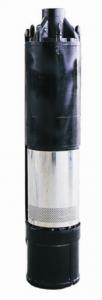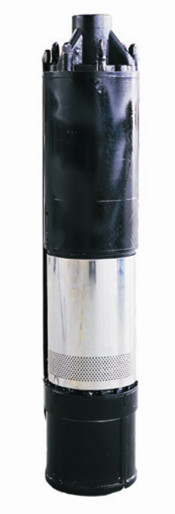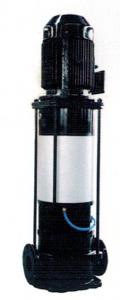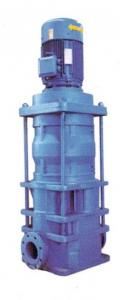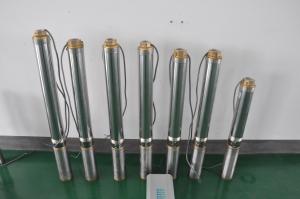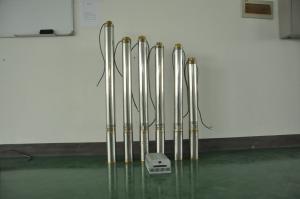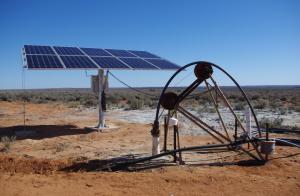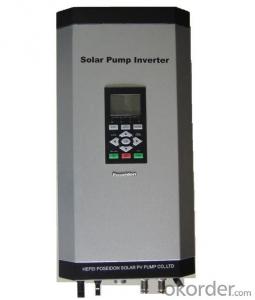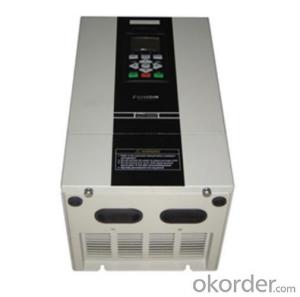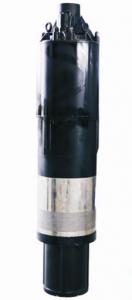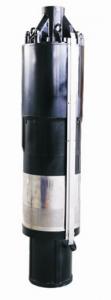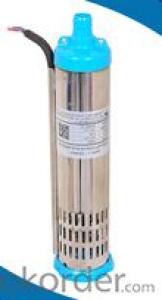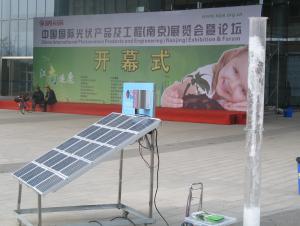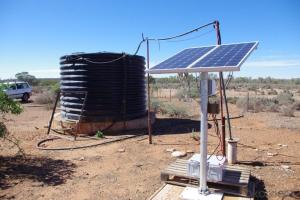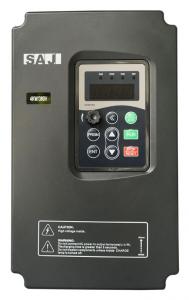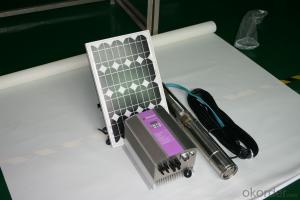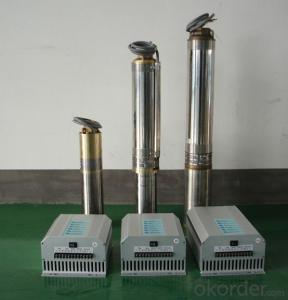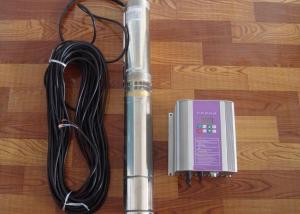Solar Water Pump 3ds-6-100 for Waterfall Feature
- Loading Port:
- China Main Port
- Payment Terms:
- TT OR LC
- Min Order Qty:
- -
- Supply Capability:
- 300 sets /month
OKorder Service Pledge
OKorder Financial Service
You Might Also Like
Product description:
Product: Solar water pump
Model:3DS-6
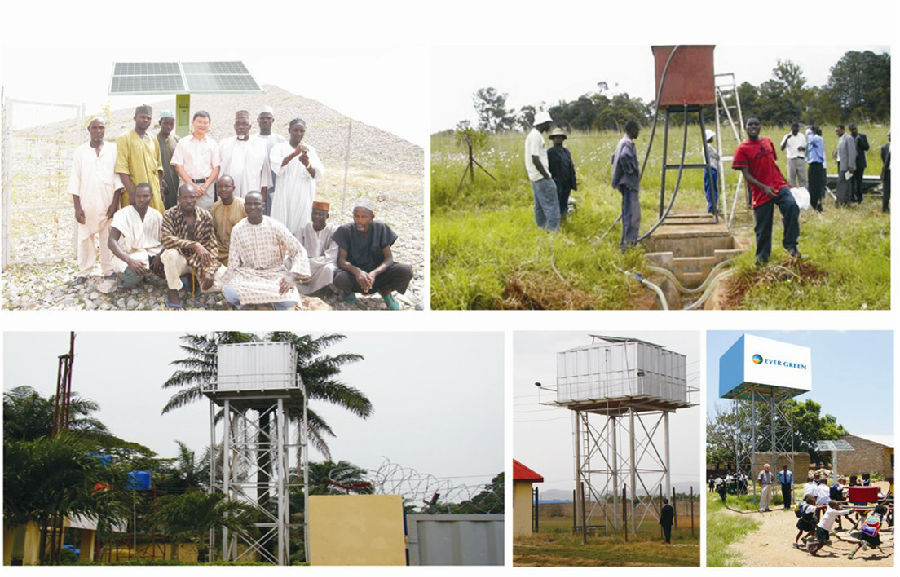 Appilication:
Appilication:
submersible pump
for deep well near a village or small farm
for drinking water of one village (100-300 people)
for watering a small farm
Product specification:
flow rate:500 liter/ hour, 4000m3/day.
lift: 70m-100m
pump diameter: 140mm
well diameter more than 150mm
with BLDC motor, motor power:600W
but only need solar power:230W, our pump can save more than 50% solar panel power.
Material:
Pump inside: stainless steel and wearable nylon,it enables our solar pump to have 10 years sevice life.
Motor length:15cm,80% shorter than other motors. So that you can pump 80% more water by our solar pump.
Certification:
3 International patent
ISO9001
CE
Warranty:2 years
- Q: Can a solar pump be used in residential buildings?
- Yes, a solar pump can be used in residential buildings. Solar pumps are increasingly being used for various applications, including water supply and heating systems in residential buildings. They harness energy from the sun and convert it into electricity to power the pump, providing a sustainable and cost-effective solution for residential water needs.
- Q: How does the angle and orientation of solar panels affect the performance of a solar pump?
- The angle and orientation of solar panels have a significant impact on the performance of a solar pump. The angle refers to the tilt of the solar panels, while the orientation refers to the direction they face. The angle at which solar panels are installed affects their efficiency by determining the amount of sunlight they receive. Solar panels work by converting sunlight into electricity, and the angle at which they are tilted determines the amount of sunlight they can capture. The optimal angle depends on the geographical location of the solar pump. For example, in regions near the equator, a flat or low tilt angle is preferable to maximize the exposure to the sun throughout the year. In contrast, in higher latitudes, a steeper tilt angle is recommended to compensate for the lower intensity of sunlight. The orientation of solar panels refers to the direction they face, typically either towards the south or north depending on the hemisphere. In the Northern Hemisphere, for instance, solar panels should face south to capture the maximum amount of sunlight. By facing south, solar panels can receive sunlight for the longest duration during the day. Similarly, in the Southern Hemisphere, solar panels should face north for optimal performance. The angle and orientation of solar panels also impact the efficiency of a solar pump by influencing the angle of incidence, which is the angle at which sunlight strikes the surface of the panels. When sunlight strikes the panels at a perpendicular angle, it is most efficiently converted into electricity. If the angle of incidence is too high or too low, the efficiency of the solar panels decreases. Adjusting the tilt angle and orientation helps to optimize the angle of incidence, thus maximizing the energy output of the solar pump. Overall, the angle and orientation of solar panels are crucial factors in determining the performance of a solar pump. By adjusting these parameters according to the geographical location, it is possible to optimize the capture of sunlight and maximize the efficiency of the solar pump.
- Q: How does a solar pump help in water conservation?
- A solar pump helps in water conservation by utilizing solar energy to power the pump, eliminating the need for electricity or fuel. This reduces the carbon footprint and energy consumption associated with traditional pumps. Additionally, solar pumps can be used in remote areas without access to electricity, allowing communities to access water resources sustainably. By harnessing renewable energy, solar pumps contribute to the conservation of water resources and promote eco-friendly practices.
- Q: Can a solar pump be used for water supply in remote islands?
- Yes, a solar pump can be used for water supply in remote islands. Solar-powered pumps are an excellent solution for remote locations where access to electricity may be limited or nonexistent. They harness energy from the sun to power the pump, drawing water from a well or other water source and supplying it to the desired location. This makes them a sustainable and cost-effective option for providing water supply in remote islands without relying on traditional power grids.
- Q: How does a solar pump help in reducing the use of chemical fertilizers?
- A solar pump helps in reducing the use of chemical fertilizers by providing a sustainable and environmentally friendly irrigation solution. By harnessing solar energy to power the pump, farmers can efficiently water their crops, leading to better nutrient absorption and healthier plants. This reduces the need for chemical fertilizers, as the optimal irrigation provided by the solar pump ensures that plants receive the right amount of water and nutrients naturally, promoting their growth and yield.
- Q: Can a solar pump be used in hydroponic systems?
- Yes, a solar pump can be used in hydroponic systems. Solar pumps are an efficient and sustainable option for providing water circulation and nutrient delivery in hydroponics. They rely on solar energy to power the pump, making them an environmentally-friendly choice for growers.
- Q: What is the expected maintenance schedule for a solar pump system?
- The expected maintenance schedule for a solar pump system typically includes regular inspections and cleaning of the solar panels, checking and tightening electrical connections, monitoring the pump's performance, and replacing any worn-out or faulty components as needed. It is recommended to conduct these maintenance activities at least once or twice a year to ensure the optimal functioning and longevity of the system.
- Q: Can a solar pump be used to pump water from a river or lake?
- Yes, a solar pump can be used to pump water from a river or lake. Solar pumps are designed to operate using energy generated from sunlight, making them a sustainable and efficient option for water pumping in remote areas. They can be utilized to extract water from various sources, including rivers and lakes, providing a reliable and eco-friendly solution for irrigation, livestock watering, and other water supply needs.
- Q: Are solar pumps suitable for use in harsh weather conditions?
- Yes, solar pumps are suitable for use in harsh weather conditions. They are designed to be weather-resistant and can withstand extreme temperatures, high winds, and heavy rains. Additionally, solar pumps do not require external power sources, making them ideal for remote areas where electricity supply may be unreliable during severe weather events.
- Q: Can a solar pump be used for swimming pool circulation?
- Yes, a solar pump can be used for swimming pool circulation. Solar pumps are designed to circulate water using energy from the sun, making them an eco-friendly and cost-effective option for pool owners. They can help maintain water quality, prevent stagnation, and ensure proper filtration and distribution of chemicals throughout the pool.
Send your message to us
Solar Water Pump 3ds-6-100 for Waterfall Feature
- Loading Port:
- China Main Port
- Payment Terms:
- TT OR LC
- Min Order Qty:
- -
- Supply Capability:
- 300 sets /month
OKorder Service Pledge
OKorder Financial Service
Similar products
Hot products
Hot Searches
Related keywords
